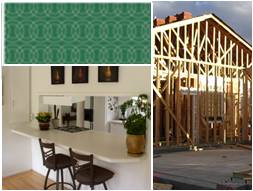
Green Building
Solar Panels
Of the solar energy benefits, the first and foremost item to note is that solar power does not produce any waste or pollution, unlike most of the other forms of energy that we have in the world today. Carbon emissions can be a thing of the past when you use solar energy instead.
Next, is the the security that solar power gives you. In the event of a power outage, your lights may still come on. Rising electricity costs in the future? Not much of a worry when you are generating your own power. Depending on the size of system you install, you may never receive an electric bill again!
A third item on the list of solar energy benefits is the cost. That's right, although there is an upfront financial investment, prices have come down significantly in recent years. Add in tax incentives and rebates and you can save up to 80% off retail. Then, consider the added value to your property. Experts estimate that for every $1 you save in annual electricity costs, its a $10 increase. So, an annual savings of $1200 translates to $12,000 in automatic equity.
Energy Efficiency
An enormous amount of energy is required to convert heated outside air to cool air conditioned inside air. However, when ultra-fine mist is released into the air around the air conditioning unit, it evaporates almost instantly creating what is known as a "flash-evaporation," which literally sucks heat out of the air as water absorbs the energy it needs to evaporate. The result of the immediate evaporation constitutes a substantial drop in ambient temperature without wetness up to 30 degrees Fahrenheit. In fact, the Tulane University Department of Mechanical Engineering has completed a study proving reseidential air conditioning efficiency systems lowers electricity costs.
Insulation
Properly insulating your home will not only help reduce your heating and cooling costs but also make your home more comfortable. You need insulation in your home to provide resistance to heat flow. The more heat flow resistance your insulation provides, the lower your heating and cooling costs.
Heat flows naturally from a warmer to a cooler space. In the winter, this heat flow moves directly from all heated living spaces to adjacent unheated attics, garages, basements, and even to the outdoors. Heat flow can also move indirectly through interior ceilings, walls, and floors—wherever there is a difference in temperature. During the cooling season, heat flows from the outdoors to the interior of a house.
To maintain comfort, the heat lost in the winter must be replaced by your heating system and the heat gained in the summer must be removed by your cooling system. Properly insulating your home will decrease this heat flow by providing an effective resistance to the flow of heat.
Unless your home was specially constructed for energy efficiency, you can usually reduce your energy bills by adding more insulation. Many older homes have less insulation than homes built today, but adding insulation to a newer home may also pay for itself within a few years.
Doors and Windows
An average home may lose 30 percent of its heat or air conditioning energy through its windows. Employing energy conservation techniques can decrease heat loss or gain. When choosing windows for a building, the usual decision criteria tend to be appearance and initial cost. But energy efficiency is also very important.
Window selection should include a number of factors, such as the different types of glazing, low-emissivity (Low-E), U-factor (U-value), R-value, Solar Heat Gain Coefficient (SHGC), Visible Light Transmission, air leakage rating, energy efficient ratings and labels, and double or triple glazing.
As of June 1, 2009, windows, doors, and skylights with U-factor and SHGC ratings of less than or equal to 0.30 are eligible for a federal tax credit of 30 percent of the product price, up to $1,500.
On-demand Water Heaters
The general premise behind a tankless water heater is to only heat water "on demand" as it is needed. This eliminates the need for a storage tank and dramatically increases energy efficiency. Almost every major shortcoming of a conventional water heater is addressed by a tankless system.
Tankless water heaters heat only when hot water is needed. Since there is no hot water storage, thermal heat loss is almost completely eliminated. Furthermore, since a tankless water heater has no refresh rate (it is instantaneous), there is no need to overheat the water to 130 or 140°F (or higher) as with a conventional tank. You can select an output temperature that matches your actually needs (usually about 105-110°F). This also saves considerable energy. For each 10°F reduction in water temperature, the U.S. Department of Energy estimates that you can save between 3%-5% in energy costs.

